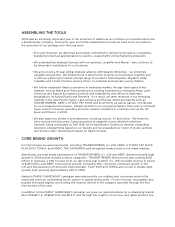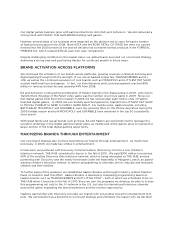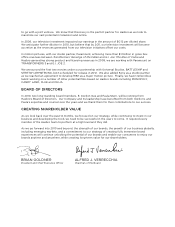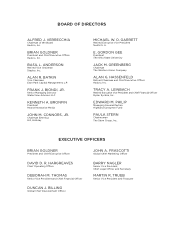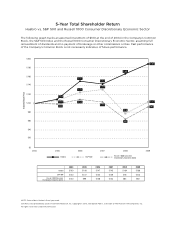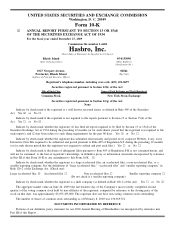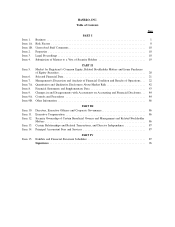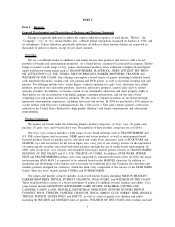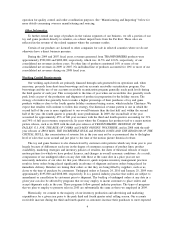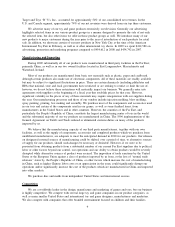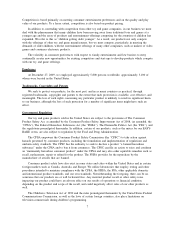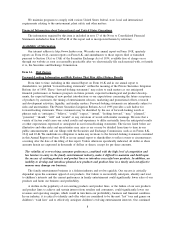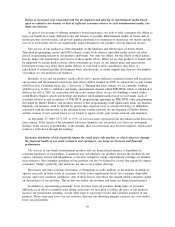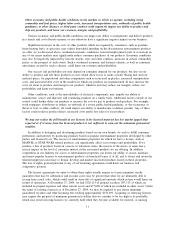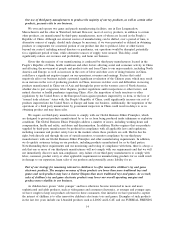Hasbro 2009 Annual Report Download - page 14
Download and view the complete annual report
Please find page 14 of the 2009 Hasbro annual report below. You can navigate through the pages in the report by either clicking on the pages listed below, or by using the keyword search tool below to find specific information within the annual report.
operation for quality control and order coordination purposes. See “Manufacturing and Importing” below for
more details concerning overseas manufacturing and sourcing.
Other Information
To further extend our range of products in the various segments of our business, we sell a portion of our
toy and game products directly to retailers, on a direct import basis from the Far East. These sales are
reflected in the revenue of the related segment where the customer resides.
Certain of our products are licensed to other companies for sale in selected countries where we do not
otherwise have a direct business presence.
During the 2009 and 2007 fiscal years, revenues generated from TRANSFORMERS products were
approximately $592,000 and $482,000, respectively, which was 14.5% and 12.6%, respectively, of our
consolidated net revenues in those years. No other line of products constituted 10% or more of our
consolidated net revenues in 2009 or 2007. No individual line of products accounted for 10% or more of our
consolidated net revenues during our 2008 fiscal year.
Working Capital Requirements
Our working capital needs are primarily financed through cash generated from operations and, when
necessary, proceeds from short-term borrowings and our accounts receivable securitization program. Our
borrowings and the use of our accounts receivable securitization program generally reach peak levels during
the third quarter of each year. This corresponds to the time of year when our receivables also generally reach
peak levels as part of the production and shipment of product in preparation for the holiday season. The
strategy of retailers has generally been to make a higher percentage of their purchases of toy and game
products within or close to the fourth quarter holiday consumer buying season, which includes Christmas. We
expect that retailers will continue to follow this strategy. Our historical revenue pattern is one in which the
second half of the year is more significant to our overall business than the first half and, within the second
half of the year, the fourth quarter is generally more predominant. In 2009, the second half of the year
accounted for approximately 65% of full year revenues with the third and fourth quarters accounting for 31%
and 34% of full year revenues, respectively. In years where the Company has products tied to a major motion
picture release, such as in 2009 with the mid-year releases of TRANSFORMERS: REVENGE OF THE
FALLEN,G.I. JOE: THE RISE OF COBRA and X-MEN ORIGINS: WOLVERINE, and in 2008 with the mid-
year releases of IRON MAN,THE INCREDIBLE HULK and INDIANA JONES AND THE KINGDOM OF THE
CRYSTAL SKULL, this concentration of revenue late in the year may not be as pronounced due to the higher
level of sales that occur around and just prior to the time of the motion picture theatrical release.
The toy and game business is also characterized by customer order patterns which vary from year to year
largely because of differences each year in the degree of consumer acceptance of product lines, product
availability, marketing strategies and inventory policies of retailers, the dates of theatrical releases of major
motion pictures for which we have product licenses, and changes in overall economic conditions. As a result,
comparisons of our unshipped orders on any date with those at the same date in a prior year are not
necessarily indicative of our sales for that year. Moreover, quick response inventory management practices
result in fewer orders being placed significantly in advance of shipment and more orders being placed for
immediate delivery. Retailers are timing their orders so that they are being filled by suppliers, such as us,
closer to the time of purchase by consumers. Unshipped orders at January 24, 2010 and January 25, 2009 were
approximately $195,000 and $108,000, respectively. It is a general industry practice that orders are subject to
amendment or cancellation by customers prior to shipment. The backlog of unshipped orders at any date in a
given year can also be affected by programs that we may employ to incent customers to place orders and
accept shipments early in the year. These programs follow general industry practices. The types of programs
that we plan to employ to promote sales in 2010 are substantially the same as those we employed in 2009.
Historically, we commit to the majority of our inventory production and advertising and marketing
expenditures for a given year prior to the peak third and fourth quarter retail selling season. Our accounts
receivable increase during the third and fourth quarter as customers increase their purchases to meet expected
4


